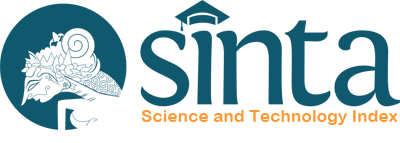Analisis Kesalahan Siswa dalam Mengerjakan Soal pada Penjumlahan dan Pengurangan Bilangan Bulat Berbasis HOTS pada Siswa Kelas V
DOI:
https://doi.org/10.28918/ijiee.v2i1.5154Keywords:
Addition, Error analysis, HOTS , Integers, SubtractionAbstract
This study aims to 1) Describe the errors made by students in solving addition and subtraction problems based on HOTS integers, 2) Describe the causes of errors made by students in working on addition and subtraction problems based on HOTS integers.This research is a descriptivequantitative research. Data collection techniques in this study were written test techniques, observation, interviews, and dosumentation. The research instrument consisted of a test sheet, an observation guide, and an interview guide. Test the validity ofthe data used in this study using triangulation. The data analysis technique used Milles and Huberman model analysis ehich consisted of data presentation, and drawing conclusions.The results of this study indicate that the errors made by students are (1)errors in the final answer (31,22%); (2) errors in undestanding the core (32,18%); (3) errors in the completion step (20,45%); (4) errors in reading the questions (0%). This is because students do not understand the concept, so students are not able to findsolutions in solving problems in the problem. So thet students do not find the results correctly and cause students to make mistakes in working on the questions.
References
Albi Anggito & Johan Setiawan. 2018. Metodologi Penelitian Kualitatif. Sukabumi: CV Jejak.
Almira Amir. 2014. Pembelajaran Matematika SD Dengan Menggunakan Media Manipulatif. Forum Peadagogik, (Vol. IV No. 1). Hlm. 73-79.
Ansori Gunawan. 2016. Analisis Kesalahan Dalam Menyelesaikan Soal Cerita Pada Mata Pembelajaran Matematika Siswa Kelas V SDN 59 Kota Bengkulu, Jurnal Ilmiah Pendidikan Guru Sekolah Dasar. (Vol. 9 No. 2). Hlm.216-225.
Arif Muhsin. 2012. Mengenal Bilangan Bulat dan Oprasinya. Jakarta: PT. Balai Pustaka. Asrori. 2020. Psikologi Pendidikan Pendekatan Multidisipliner. Banyumas: Pena Persada.
Dela Ruswati, dkk. 2018. Analisi Kesalahan Siswa SMP Dalam Menyelesaikan Soal Kemampuan Pemecahan Masalah Matematis Ditinjau Dari Tiga Aspek, Maju. (Vol.5 No.1). Hlm. 91-107.
Eko Sugiarto. 2015. Menyusun Proposal Penelitian Kualitatif. Yogyakarta: Suaka Medika.
Fauddillah Ali Sofyan, dkk. 2020. Analisis Kesulitan Belajar Matematika Berbasis Hots Pada Siswa Kelas IV, Jurnal Pendidikan Dasar Islam. (Vol. 7 No.1). Hlm. 90-97.
Ganik Wahyuningtias Sunardiningsih, dkk. 2019. Analisis Kesalahan Siswa Dalam Menyelesaikan Soal Matematika Berdasarkan Analisis Newman, Jurnal Terapan Sains & Teknologi. (Vol.1 No.2). Hlm. 41-45.
Johni D. 2013. Metodologi Penelitian Pendidikan dan Aplikasinya pada Pendidikan Anak Usia Dini (PAUD). Jakarta: Kencana.
Laurentius Pradipta Yudhautama & Novisita Ratu. 2019. Pengembangan Alper Silabu Pada Materi Bilangan Bulat Kelas IV, Jurnal Review Pembelajaran. (Vol.4 No 1). Hlm. 72-84.
Nurlita, dkk. 2016. Mikrosepsi Konsep Prasyarat Aljabar Mahasiswa Pendidikan Guru Madrasah Ibtidaiyah, Jurnal Didaktik Matematika. (Vol. 3 No.2). Hlm. 85-95.
Nurul Farida. 2015. Analisis Kesalahan Siswa SMP Kelas VII Dalam Menyalesaikan Masalah Soal Cerita Matematika, Jurnal Pendidikan Matematika FKIP Univ. Muhammadiyah Metro. (Vol.4 No. 2). Hlm. 42-52.
Nur Queen Radiat Marpaung. 2018. Analisis Kesalahan Siswa Dalam Menyelesaikan Soal Matematika di MTs Swasta Aisyiyah Sumatera Utara. Skripsi. Sumatera Utara: Universitas Islam Negeri Sumatera Utara Medan.
Prakitipong, N. & Nakamura, S,. 2006. “ Analysis of Mathematics Performance of Grade Five Students in Thailand Using Newman Prosedur”. Journal Of International Cooperation In Education. 9 (1). 113
Rini Yulia, Fauzi, Awaluddin. 2017. Analisis Kesalahan Siswa Mengerjakan Soal Matematika Di Kelas V SDN 37 Banda Aceh, Jurnal Ilmiah Pendidikan Guru Sekolah Dasar FKIP Unsyah. (Vol. 2 No.1). Hlm. 124-131.
Reva Gitriani, dkk. 2018. Pengembangan Lembar Kerja Siswa Berbasis Pendekatan Kontekstual pada Materi Lingkaran untuk Siswa SMP. Jurnal Review Pembelajaran Matematika. (Vol. 3 No.2). Hlm. 4.
Simarmata dkk. 2020. Pembelajaran STEM Berbasis HOTS dan Penerapannya. Medan: Yayasan Kita Menulis.
Suganda, Andang. 2019. Pentingnya Bilangan Bulat. Yogyakrta: Deepublish.
Sugiyono. 2011. Metode Penelitian Pendidikan Pendekatan Kuantitatif, Kualitatif, dan R&D. Bandung: Alfabeta.
Sugiyono. 2015. Metode Penelitian Pendidikan Pendekatan Kuantitatif, Kualitatif, dan R&D. Bandung: Alfabeta.
Suparni Ibrahim. 2010. Strategi Pembelajaran Matematika. Yogyakarta: Bidang Akademik.
Wardati Khumairah Rusdi. 2020. Analisis Kesalahan Dalam Menyelesaikan Soal Cerita Matematika Tipe HOTS Berdasarkan Gender (Studi Kasus Pada Siswa Kelas V SDI Surya Buana Kota Malang). Skripsi. Malang: Universitas Islam Negeri Maulana Malik Ibrahim Malang.
Yuniantika & Esti Harini. 2018. Penerapan Metode Pembelajaran Index Card Match Untuk Meningkatkan Minat dan Prestasi Belajar Matematika Siswa Kelas II SD N Wirokerten Yogyakarta. Jurnal Pendidikan Ke-SD-an. (Vol. 4 No. 2). Hlm. 348
Yunita Wildaniati. 2015. Pembelajaran Matematika Operasi Hitung Bilangan Bulat Dengan Alat Peraga, Elementary. (Vol.1 No. 1). Hlm. 33-40.
Downloads
Published
Issue
Section
License
Copyright (c) 2022 Ninik Anggarani, Rosidah Aliim Hidayat

This work is licensed under a Creative Commons Attribution 4.0 International License.
You are free to:
Share — copy and redistribute the material in any medium or format for any purpose, even commercially.
Adapt — remix, transform, and build upon the material for any purpose, even commercially.
The licensor cannot revoke these freedoms as long as you follow the license terms.
Under the following terms:
Attribution — You must give appropriate credit , provide a link to the license, and indicate if changes were made . You may do so in any reasonable manner, but not in any way that suggests the licensor endorses you or your use.
No additional restrictions — You may not apply legal terms or technological measures that legally restrict others from doing anything the license permits.
Notices:
You do not have to comply with the license for elements of the material in the public domain or where your use is permitted by an applicable exception or limitation .
No warranties are given. The license may not give you all of the permissions necessary for your intended use. For example, other rights such as publicity, privacy, or moral rights may limit how you use the material.














